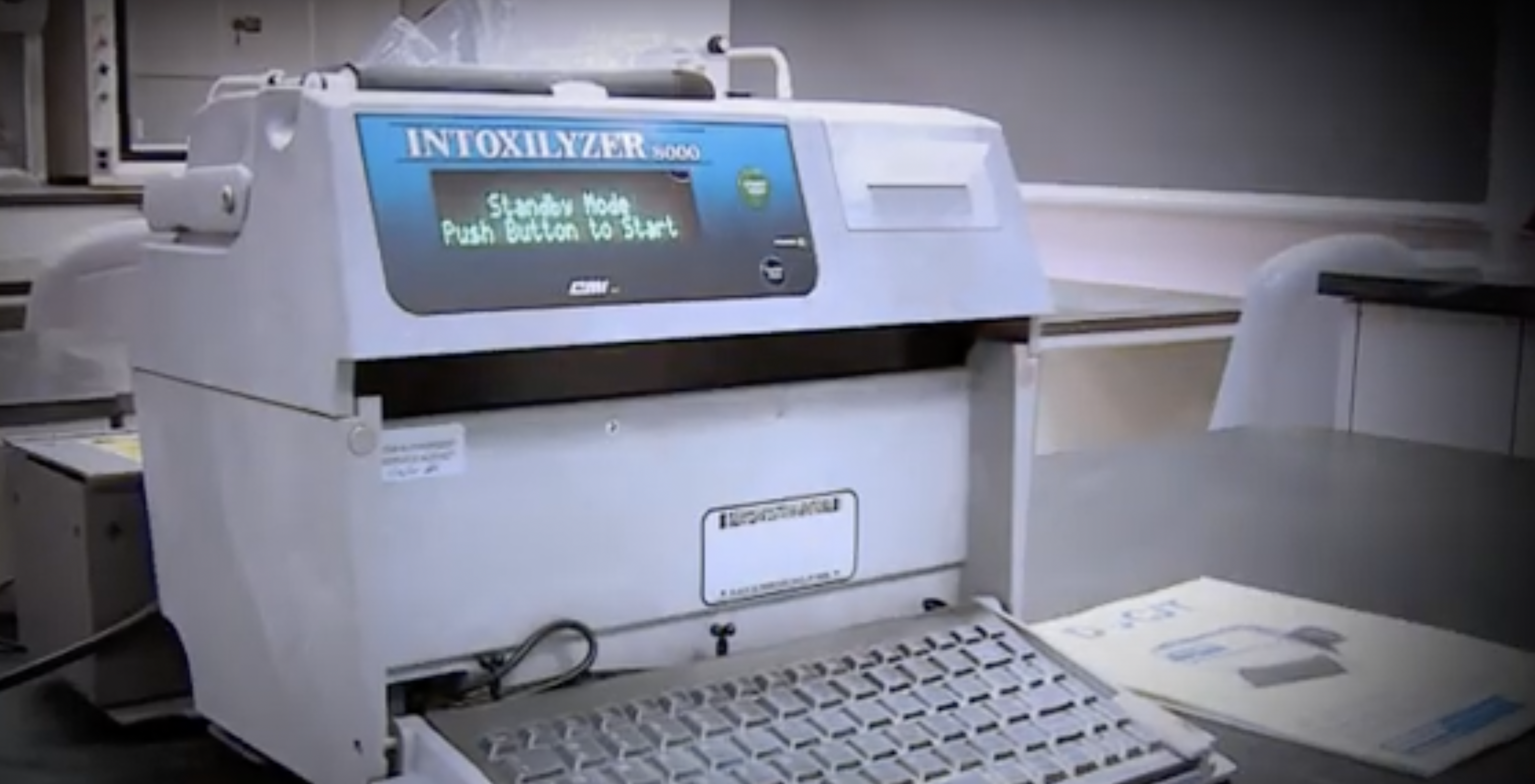How To Win a DUI Breath Test Case

One of the best ways to win a DUI breath test case (sometimes called the “DUBAL”) is to get the court to suppress the breath test, making it inadmissible at trial.
In one of our recent cases, the Honorable Mary Catherine Green, in the courthouse in Lakeland, FL, suppressed our client’s breath test reading that was over the legal limit of .08. The case was published in Florida Law Weekly as State v. Mitchell, 31 Fla. L. Weekly Supp. 213a. (Polk Cty. Ct. 2023).
After getting the breath test excluded, we set the case for a jury trial. The prosecutor dropped the DUI charge, which was the only charge, right before the trial was scheduled to begin.
At the hearing, we provided the Court with a copy of all trial orders suppressing a breath test because of compliance issues. This article summarizes all of those cases published in Florida Law Weekly. If you find a case we missed, please let us know so we can add it here.
State v. Mitchell, 31 Fla. L. Weekly Supp. 213a. (Polk Cty. Ct. 2023)
Defense Attorney: Leslie M. Sammis, Sammis Law Firm, P.A., Tampa, for Defendant.
An attorney at the Sammis Law Firm filed a motion to suppress the breath test reading because of a failure to comply with the Implied Consent Law (Section 316.1932, Fla. Stat.) and Rule 11D-8, Florida Administrative Code. At the evidentiary hearing, the State presented testimony from Officer Camilo Almedia, the Agency Inspector for the Intoxilyzer 8000 instrument at the Lakeland Police Department, and Taylor Gutschow, a Department Inspector of the Intoxilyzer 8000 instrument for the Florida Department of Law Enforcement (FDLE).
After considering the testimony and exhibits introduced into evidence at the hearing, the Court made the following findings:
“On July 9, 2021, an agency inspection of the instrument was conducted at the Lakeland Police Department by Officer Almedia, the Agency Inspector. The instrument failed the first inspection by producing “ambient fail”, “control outside tolerance”, and “non-compliance” error codes. No reason was noted on the Agency Inspection Report for repeating the test. However, without explanation, Officer Almedia conducted a second test on the instrument.
The instrument also failed the second test showing “control outside tolerance,” “control outside tolerance”, and “non-compliance error codes”. Officer Almedia then conducted a third test on the instrument, noting on the Agency Inspection Report “Air tight seal checked and confirmed, reconnected, met standard”. Officer Almedia certified on the Agency Inspection Report that the instrument complied with 11D-8, FAC and that he performed the inspection in accordance with the provisions of Chapter 11D-8, FAC…..
In September, 2021, the instrument failed the agency inspection during the first test. The test was repeated, the reason was noted on the Agency Inspection Report, and there were no issues with the second test. The instrument was certified as in compliance with 11D-8, FAC…..
On January 25, 2022, the instrument failed the agency inspection during the first test showing “RFI Detect” and “05:Interferent Detect” error codes. The Agency Inspection Report notes the inspector “accidentally” used the wrong sim and the instrument was too close to the printer which caused RFI. The sim card was replaced, the instrument was moved away from the printer, the test was repeated, and the reasons handwritten on the Agency Inspection Report. There were no issues with the second test. The instrument was certified as in compliance with 11D-8, FAC…..
In April 2022, the instrument did not pass its annual inspection, the Department required it to remain out of evidentiary use and recommended the Lakeland Police Department send it for repairs….
Based upon these findings, the Court concludes the July 9, 2021 agency inspection, which was required before the instrument could be returned to evidentiary use, was not conducted in substantial compliance with 11D-8, FAC, and therefore could not provide sufficient reliability that the instrument met the requirements of FAC to be placed into evidentiary use. Breath results are admissible into evidence only upon compliance with the statutory provisions and administrative rules of the Implied Consent law. See State v. Donaldson, 579 So. 2d 728 (Fla. 1991). Subsequent monthly agency inspections do not cure the lack of substantial compliance. It is therefore,
ORDERED AND ADJUDGED:
1. The Motion to Suppress or Exclude Breath Test Results for Lack of Substantial Compliance is GRANTED.
2. Defendant’s breath test results are excluded as evidence in this cause.”
State v. Rotroff, 30 Fla. L. Weekly Supp. 434a (DeSoto Cty. Ct. 2022)
Defense Attorney: Keeley Karatinos, Karatinos Law, PLLC, Dade City, for Defendant.
Defendant argued in his Motion to Suppress and at the hearing that the results of the breath tests administered to Defendant on 31 October 2021 should be suppressed because they are scientifically unreliable. Specifically, the Defendant argued that the tests administered on the Defendant were not in compliance with the statutes and administrative rules governing breath tests because the Intoxilyzer 80-001340 “did not pass the November 2021 Agency Inspection, and was taken out of evidentiary use as a result of the Department Inspection.” Def.’s Mot. to Suppress, pg. 3.
After the hearing on the motion, the Court entered the following order:
1. “Because implied consent revolves around a defendant consenting to an “approved chemical test” of his breath, and because the FDLE Inspector tasked with ensuring the scientific accuracy and reliability of the instrument utilized cannot attest to the scientific reliability of the Intoxilzer 80-001340 at the time the Defendant gave his breath sample, the Court hereby GRANTS the Defendant’s Motion to Suppress.
2. Further, should this Motion have been more properly heard as a Motion in Limine, the Court hereby GRANTS same as any probative value is far outweighed by the prejudicial effect of the potential scientific unreliability of the Intoxilyzer 80-001340.
3. The Court hereby excludes any mention of, reference to, or inquiry regarding Deputy Nunez’s request for a breath test, the Defendant’s response to the request, as well as any testimonial, physical, or scientific evidence obtained as a result of that request.
4. Observations or statements of the Defendant made subsequent to Deputy Nunez’s request for a breath test are not excluded by virtue of this Order as long as they do not contain reference to the breath test or breath test results. The Court specifically makes no finding as to observations or statements of the Defendant made subsequent to Deputy Nunez’s request for a breath test that do not contain reference to the breath test or breath test results and these issues may be addressed in a properly filed Motion in Limine or Motion to Suppress.”
State v. Wynn, 28 Fla. L. Weekly Supp. 565b (Nassau Circuit Ct. 2020)
Defense Attorney: Susan Z. Cohen, Epstein & Robbins, Jacksonville, for Appellee.
After the trial court granted the motion to suppress the breath test for a lack of substantial compliance with the administrative rules, the State appealed. The appellate court affirmed the trial court’s decision, upholding the suppression of the breath test.
The appellate court reasoned:
“At the suppression hearing, there was no factual dispute about when the monthly agency inspections of the intoxilyzer machine did or did not occur. Immediately prior to the hearing on Wynn’s motion to suppress, the trial court held a Richardson1 hearing where the parties agreed the court would exclude from evidence the December 2018 agency inspection report.
Additionally, the parties did not dispute the absence of an inspection report for January 2019. Thus, it is uncontroverted that the intoxilyzer used to test Wynn’s breath alcohol level underwent an inspection on November 9, 2018, that officers used the intoxilyzer to test Wynn’s breath on December 10, 2018, and that no inspection took place in December 2018 or in January 2019. Additionally, the parties agreed that the NCSO shipped the intoxilyzer to its manufacturer in January 2019 for maintenance because the machine would not “power on” properly.
On these uncontested facts, the State failed in its obligation to demonstrate substantial compliance with the monthly inspection requirement in rule 11D-8.006(1).
Although the rule does not require inspections be performed every thirty days, it does specify that each breath machine shall be inspected at least one time each calendar month.
The evidence showed only one inspection report thirty-one days before Wynn submitted to the breath test and no inspections in the following two months.
Thereafter, the machine was sent for repairs because it would not power on. Under the circumstances, the trial court properly determined the State’s failure to present evidence of inspection reports for December and January was not insubstantial….
In sum, because the State failed to show substantial compliance with Rule 11D-8.006, it may not rely on the presumptions of the implied consent law to move Wynn’s breath test results into evidence, period. See § 316.1932(1)(b)2., Fla. Stat. (2018). The trial court correctly determined, on this record, that the State failed in its obligation to show the machine used to test Wynn was properly inspected on a monthly basis, albeit for a slightly different reason than is outlined in this order.
In view of the above, the county court’s “Order on Defendant’s Motion to Suppress” entered on October, 15, 2019, is AFFIRMED.
State v. Swindle, 23 Fla. L. Weekly Supp. 613a (Hillsborough Cty Ct. 2015)
The defense filed a Motion to Suppress because “the Florida Department of Law Enforcement (FDLE) improperly approved a particular lot of alcohol reference solution, which solution was subsequently used to perform a series of monthly agency inspections of the Intoxilyzer 8000 that produced the breath results in this case.” The trial court granted the motion finding:
“Because one result was outside the acceptable range on the first day of testing, the Court finds that Lot #201302B could not be lawfully approved for use during agency inspections. The Court further finds that the retesting performed on April 17, 2015 is not authorized by the Rule. Although the Rule specifies that a minimum of ten bottles may be tested from each lot, and does not specify a maximum, it also specifies that “. . .Duplicate analyses will be performed on each sample bottle of alcohol reference solution. . . (emphasis added)”.
Thus, given the use of the word “duplicate,” it would appear to the Court that a maximum of two analyses is permitted for each bottle. Even assuming for sake of argument that additional analyses of each bottle were permitted by the Rule, the Court finds that the additional results obtained on April 17, 2013 would simply add to the total results obtained the day before, and would constitute one continuous analysis of Lot #201302B conducted over two days, and would not constitute a “retest” that would allow FDLE to disregard the unacceptable result from April 16, 2015.”
State v. Liley, 23 Fla. L. Weekly Supp. 271b (Hillsborough Cty Ct. 2015)
The defense filed a motion to suppress the breath test results because unapproved alcohol reference solutions were used in both the September 2013 department inspection as well as the monthly agency inspections. The court found:
…based upon the testing completed on lot number 201302B, that 10 bottles were tested in duplicate on two (2) separate days, yielding a total of 40 results for which not all of the results fell within acceptable range. Therefore, lot number 201302B was not properly approved in accord with FDLE Rule 11D-8.0035 and the use of these non-approved solutions during the September department inspection or the monthly agency inspections in October and November violated forms 36 and 39, thereby rendering the results inadmissible…..For these reasons, the court grants the motion to suppress the breath test results.
State v. Larkin, 23 Fla. L. Weekly Supp. 271b (Hillsborough Cty. Ct. 2015) –
The defendant was arrested for DUI and filed a motion to suppress “because unapproved alcohol reference solutions were used in both the September 2013 department inspection as well as the monthly agency inspections” of the breath test machine. The court granted the motion, stating:
The State argues that FDLE was permitted to reanalyze the solution per the FDLE alcohol testing program procedures manual. The defense, on the other hand, argues that the promulgated rule (11D-8.0035) prohibits re-analysis. The issue is resolved by the FDLE procedures manual. On page 2 of the FDLE alcohol testing program manual, it states that the purpose of the manual “is to document the procedures of the Florida Department of Law Enforcement alcohol testing program. It is not intended to supersede, and when in conflict, is subordinate to, information and processes in the Florida Statutes, Florida Administrative Code, or FDLE policies and procedures”. Since FDLE 11D-8.0035 requires all results to fall within the acceptable range, this court finds that the promulgated rule and section 2.14 of the FDLE alcohol testing program procedures manual to be in conflict and, therefore section 2.14 is subordinate to the promulgated rule (11D-8.0035) and therefore, retesting is not permitted since 11D-8.0035 requires all of the results must fall within the acceptable range.
The lot at issue was not properly approved, and the use of the non-approved solutions during the department inspections rendered the results inadmissible.
The court further stated that “[s]ince the State made no argument for substantial compliance, this court need not make any ultimate legal findings on this point of law. But, since the State is seeking further appellate review, it should be noted that (Thirteenth Circuit courts) found that the doctrine of substantial compliance did not apply to FDLE or rule 11D-8.0035. Had the State argued this point during the hearing, the court would have rejected the State’s position.”
The court also stated that a Brady violation had probably occurred, but “by granting the motion to suppress for violating FDLE Rule 11D-8.0035, the court does not have to go any further on this issue as it has been rendered moot.”
State v. Brink, 20 Fla. L. Weekly Supp. 772a (Fla. 17th Cir. Ct. 2013)
The circuit court, sitting in its appellate capacity, affirmed the lower this granting of the defendant’s motion to suppress evidence related to breathalyzer testing in this driving under the influence case, holding that there was no error in granting the motion to suppress where the trial court, after hearing conflicting evidence regarding the inspection of Intoxilyzers, found that fraudulent practices and intentional, systematic destruction of evidence occurred when “plug pulls” (a loss of power to the machine, causing it to lose data) erased data from failed inspections, and holding that the finding was supported by competent, substantial evidence. See also State of Florida v. Medina, Case No. 09-78AC10A [18 Fla. L. Weekly Supp. 170a].
State v. Hoover, 20 Fla. L. Weekly Supp. 776a (Fla. 17th Cir. Ct. 2013)
The circuit court, sitting in its appellate capacity, affirmed the lower court’s granting of the defendant’s motion to suppress evidence related to breathalyzer testing in this driving under the influence case, holding that it was not an abuse of discretion to suppress breath test results based on a lack of substantial compliance with the rules governing Intoxilyzer 8000 (the breathalyzer testing machine used) inspections, where the rules require that inspectors rinse their own mouths with alcohol before blowing into the machine. In this case, the inspector rubbed alcohol on her own lips and gums before testing the machine, and did not rinse with the solution; this was the only inspector known to use this technique.
State v. Ikramelahai, 20 Fla. L. Weekly Supp. 772b (Fla. 17th Cir. Ct. 2013)
The circuit court, sitting in its appellate capacity, affirmed the lower this granting of the defendant’s motion to suppress evidence related to breathalyzer testing in driving under the influence case, holding that there was no error in granting the motion to suppress where the trial court, after hearing conflicting evidence regarding the inspection of Intoxilyzers, found that fraudulent practices and intentional, systematic destruction of evidence occurred when “plug pulls” (a loss of power to the machine, causing it to lose data) erased data from failed inspections, and holding that the finding was supported by competent, substantial evidence.
State v. Viera, 20 Fla. L. Weekly Supp. 773a (Fla. 17th Cir. Ct. 2013)
The circuit court, sitting in its appellate capacity, affirmed the lower court’s granting of the defendant’s motion to suppress evidence related to breathalyzer testing in driving under the influence case, holding that there was no error in granting the motion to suppress where the trial court, after hearing conflicting evidence regarding the inspection of Intoxilyzers, found that fraudulent practices and intentional, systematic destruction of evidence occurred when “plug pulls” (a loss of power to the machine, causing it to lose data) erased data from failed inspections, and holding that the finding was supported by competent, substantial evidence.
State v. Hoover, 20 Fla. L. Weekly Supp. 776a (Fla. 17th Cir. Ct. 2013)
The circuit court, sitting in its appellate capacity, affirmed the lower court’s granting of the defendant’s motion to suppress evidence related to breathalyzer testing in this driving under the influence case, holding that it was not an abuse of discretion to suppress breath test results based on a lack of substantial compliance with the rules governing Intoxilyzer 8000 (the breathalyzer testing machine used) inspections, where the rules require that inspectors rinse their own mouths with alcohol before blowing into the machine. In this case, the inspector rubbed alcohol on her own lips and gums before testing the machine, and did not rinse with the solution; this was the only inspector known to use this technique.
State v. Osorio, 19 Fla. L. Weekly Supp. 734 (May 18, 2012, 7th Judicial Circuit)
During the Agency Inspector’s first inspection on this Intoxilyzer 8000 breath test machine, he testified he took too long and the Intoxilyzer timed out. A second inspection was done, and during this attempt, the Inspector believed he used too much mouth alcohol, causing the machine to reflect “slope not met,” causing the Inspector to abort this second test and start a third one. The third test was aborted by the inspector due to the possibility that a radio frequency interferent would be detected in the room. Finally, a fourth inspection was started, which resulted in a successful inspection. During these four attempts, the inspector did not contact the FDLE Department Inspector or record the reasons for the non-compliant rest results in the remark section of Form 40 as required. The Court ruled that since the machine was never taken out of service as required by Form 39, the department inspector was never contacted as required by the rules, and the remarks were not recorded on Form 40 as required by the rules the machine was not in substantial compliance. As this case shows, multiple compounded deviations from the procedures set forth by the Administrative Rules cause the Intoxilyzer 8000 machine to not be in substantial compliance.
Bruns v. State, 15 Fla. L. Weekly Supp. 958b (August 14, 2008, 8th Judicial Circuit).
The machine in question was inspected on January 23 and did not pass the simulator test. During the retest, the machine failed again. The Intoxilyzer 8000 breath test machine was not removed from service according to Form 39 and was instead tested again on January 24. During this test, the Intoxilyzer failed both the initial and retest. The machine was again left in service. Two days later, the testing procedure was performed again, and the test was completed successfully. Before the subject provided a breath sample, the machine was never removed from service. The Court ruled that because the agency deviated from the requirements of Form 39, the breath machine was not in substantial compliance.
State v. Reich, 13 Fla. L. Weekly Supp 631a (January 9, 2006, 16th Judicial Circuit).
During the hearing, Defendant presented evidence that the reading during the February 2004 agency inspection was out of the acceptable range. The maintenance witness did not notice this, and no corrective action was taken—the machine was not removed from service. The State argued that even with this out of tolerance on the .08 test, the machine was in range on the .05 and .20 tests. The State also argued that subsequent inspections were within tolerance. The Court disagreed and stated that substantial compliance means unequivocally that the instrument passes all of the tests, which it did not. Additionally, the following problems were found:
- the mouth alcohol test run in December 2004 produced an incorrect result—giving an actual reading instead of detecting alcohol presence;
- the January 2005 alcohol free acetone test provided an error of “unable to obtain stable reference” with no credible explanation from the technician;
- the radio frequency interference tests were conducted improperly.
As a result, the Court ruled that the State could not meet its burden of demonstrating substantial compliance, and the breath test results were excluded from the trial.
State v. Stephenson, 13 Fla. L. Weekly Supp. 797c (April 28, 2006, 16th Judicial Circuit).
The Intoxilyzer 8000 machine, in this case, presented an “out of tolerance” reading of .086 during the February 2004 agency inspection. The agency inspector did not take any corrective action, and FDLE later discovered an error and informed the inspector. The Court ruled that this reading is per se failure. The State attempted to argue that the other tests performed on that inspection were within range and the inspections in subsequent months were within tolerance so there was substantial compliance. The Court disagreed and found that the Deputy’s inability to remember possible explanations for the results and any steps he took to correct the problems showed a lack of substantial compliance. So, in that case, the breath test reading was suppressed because the State did not meet its burden of demonstrating substantial compliance, given the number of irregularities and the machine’s lack of correction or maintenance.
State v. Wright, 14 Fla. L. Weekly Supp. 167c (December 15, 2006, 7th Judicial Circuit).
During the April monthly inspection, the Intoxilyzer 8000 used in that case did not detect acetone in any of the test solutions, even after the inspector submitted the solution a second time (thereby doing two tests). The inspector did not include any comments in the remarks portion of Form 40 to explain any reasoning for this abnormality. The inspector informed the State Attorney’s office that he did not know why the machine did not detect the acetone, and immediately began another test—which was normal. Another test was done a month later, which was also normal. The Court pointed out that the substantial compliance rules dictate that if a check or test is repeated, the reason for that repeat must be entered when prompted and recorded on Form 40-which was not done on the first or second test. The Court also pointed out that if the machine does not comply, the inspector is required to remove the instrument from service and notify the Department inspector, which was not done in this case. The Court found the machine not to be in substantial compliance based on the April test being repeated and then restarted (in violation of the rule that the test can only be repeated once), the fact that the machine was not taken out of service after it failed to comply, and the fact that the inspector did not know why the machine was malfunctioning and failed to indicate a reason on Form 40.
State v. McGrath, 9 Fla. L. Weekly Supp. 631b (July 17, 2002, 14th Judicial Circuit).
The Intoxilyzer 8000, in that case, emitted high and low tones during the subject’s breath test. The defense expert testified this was an indication of a malfunction of the instrument. Inspections were done in August 2001, September 2001, October 2001, November 2001, and December 2001. The printer was not functioning correctly during each inspection, and the print cards had numerous errors. According to FDLE Form 16, print cards must be legible. Experts testified that printer problems may result from malfunction of the test instrument’s microprocessor or computer functions. The prosecution argued that because the instrument’s test results fell within acceptable ranges, this problem went to the weight rather than the admissibility of the breath test reading. The court disagreed and found that numerous problems rendered the test results in the case unreliable.
Conclusion
If you are charged with a DUI case involving a breath test reading over .08 in Tampa, FL, or the surrounding counties in Tampa Bay, contact an experienced criminal defense attorney.
Our Tampa DUI attorneys are experienced in fighting DUBAL (driving with unlawful BAC level) cases in Hillsborough County and the surrounding counties of Hernando County, Pasco County, Manatee County, and Polk County, FL.
Call 813-250-0500 to discuss your DUI BAC case today.














